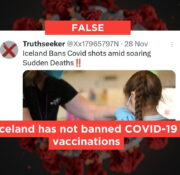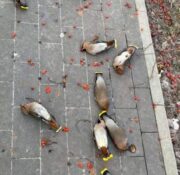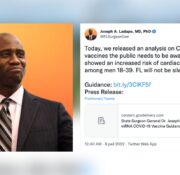A mysterious cat disease in Poland took over social media early last week. The lack of publicly available verified data and the late announcements of the Chief Veterinary Officer were very noticeable in the first days. The resulting information gap and the emotions accompanying these reports created ideal conditions for spreading unproven theories. Official data is very scarce. Here’s what we’ve found so far — we’ll update this article as soon as we get any new and relevant information.
Recommendations for cat owners
- Do not feed cats raw meat;
- Keep cats indoors, whenever possible;
- Any release of the animal to the balcony or terrace should be preceded by cleaning the floor with standard detergents;
- Prevent contacts between cats and other wild animals, including birds;
- Prevent cats from coming into contact with footwear that is used outside;
- Only feed your cats food coming from reliable sources;
- Wash your hands after touching other animals (follow standard hygiene rules after coming back home).
It is likely that infected cats would shed virus via the gut and respiratory tract, so any suspected cases should be isolated from other pets.
Cat disease — symptoms
If you notice disturbing symptoms, such as loss of appetite, listlessness, stiffness of the limbs, shortness of breath, pupils of different sizes, pupils that do not react to light, convulsions or epileptic seizures, take your cat to the veterinarian immediately.
Cat disease — first reports
The first information about the observed cases surfaced on a closed veterinary group, where doctors exchanged observations about an unexplained cat disease. On 19 June, the information spread beyond the group thanks to a behaviourist who published a screenshot of one of the posts on her profile and warned Internet users against feeding poultry meat to cats. Understandably, this has caused concern among cat owners.
In response to numerous inquiries, veterinary clinics began to publish information on their profiles, urging people to apply basic safety rules, including, above all, not letting cats outside. According to doctors’ observations, the disease attacks both young and old cats, living indoors or outside, fed wet or dry food. The disease is characterized by a rapid course and high mortality rates.
Cat disease — official information
20 June 2023
On Tuesday, the news was addressed by Chief Veterinary officer who stated that at the moment, there is no evidence that the symptoms observed in cats are caused by an infection with the avian influenza virus. The CVO did not have data on the number of sick cats or the results of samples taken from them on that day.
On the same day, the Deputy Chief Veterinary Officer sent a letter to the President of the Polish National Veterinary Chamber. In it, he appealed for immediate reporting to district veterinarians of positive results of laboratory tests for avian influenza obtained from animals other than birds, in particular from companion animals. At the same time, they expressed concern about “veterinarians casually and publicly expressing unsubstantiated judgments that the symptoms found in cats are probably the result of infection with avian influenza virus after feeding animals raw poultry or pork.” In the opinion of the CVO, such statements pose a risk of being perceived by the public as a result of the lack of proper supervision over the breeding and slaughter of farm animals and as a threat to food safety.
21 June 2023
On Wednesday, the Pomeranian Voivodeship Veterinary Officer informed that in the last two weeks, 28 cats with neurological and respiratory symptoms were treated in Gdańsk. Unfortunately, 25 of them did not survive.
22 June 2023
On Thursday, Animallab informed that the total number of cases in Poland reached 86.
23 June 2023
On Friday, the CVO published information about the first results of research conducted at the Veterinary Institute in Puławy. The results of the Tri-City samples indicated an influenza virus. However, the message did not specify the type of virus — research to determine this information was ongoing.
24 June 2023
On Saturday, a team of the Institute of Veterinary Medicine of the Warsaw University of Life Sciences in cooperation with Dr. hab. Tomasz Dzieciątkowski from the Medical University of Warsaw confirmed an infection with the H5N1 influenza virus in a cat from the Mazowieckie Voivodeship.
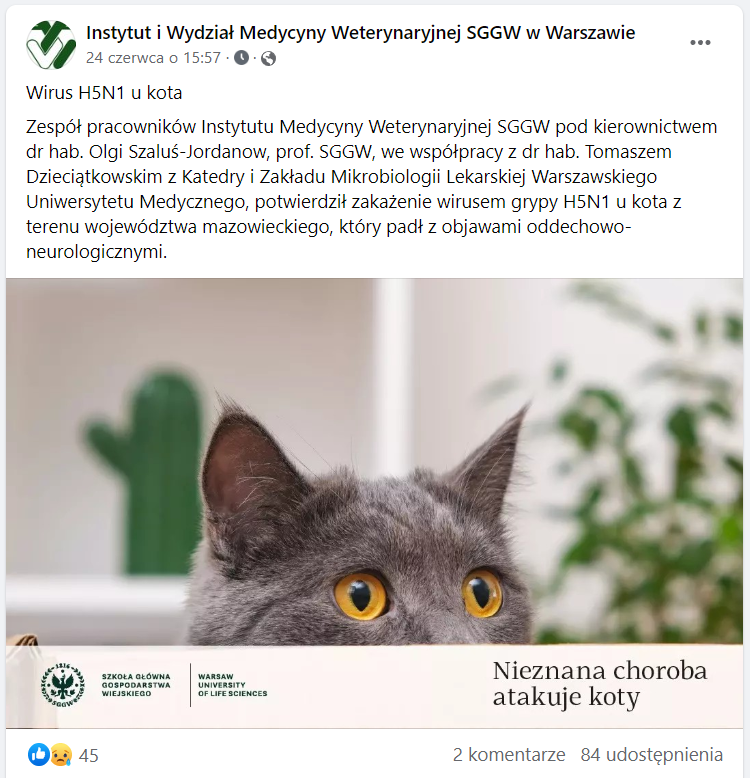
26 June 2023
On 26 June, the CVO issued another announcement. The Institute in Puławy finished examining samples from Lublin and Poznań. In total, 11 samples were tested at the institute, together with the material from Tri-City cats. 9 of them tested positive for H5N1. However, the source of infection remains unknown.
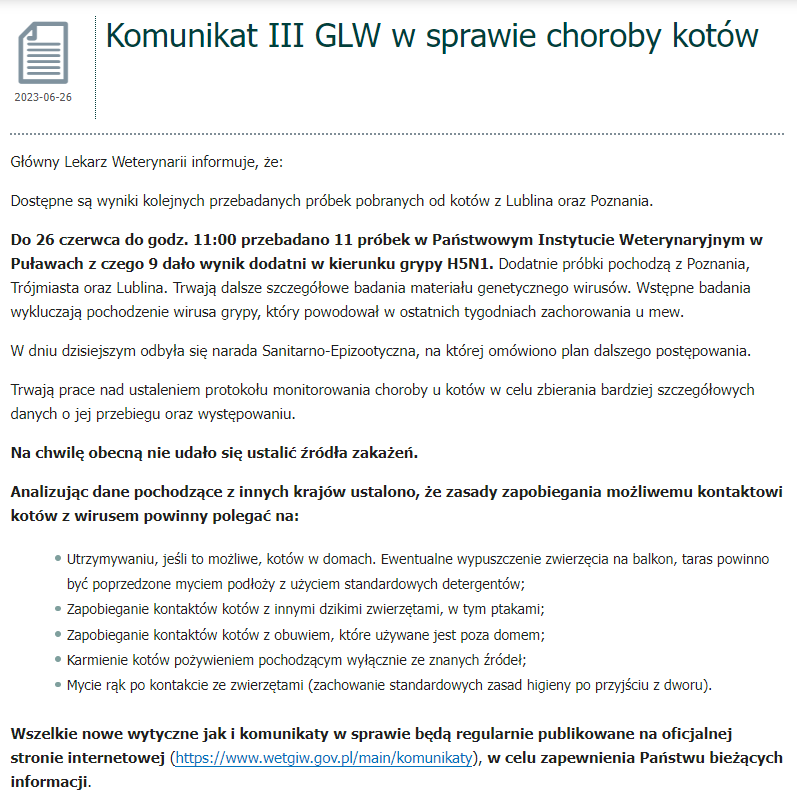
28 June 2023
On Wednesday, the CVO informed that the National Veterinary Institute in Puławy received a total of 33 samples from cats from Gdańsk, Gdynia, Poznań, Lublin, Pruszcz Gdański, Nowy Dwór Mazowiecki, Bydgoszcz, Wrocław and the vicinity of Zamość. As of that day, 19 of them were tested and 15 gave positive results for the H5N1 influenza virus. Positive samples came from Gdańsk, Gdynia, Pruszcz Gdański, Lublin, Bydgoszcz and Poznań. With the sample from Warsaw tested earlier at the Warsaw University of Life Sciences, we have a total of 16 confirmed foci of the disease.
30 June 2023
The University of Gdańsk informed about the results of the cooperation between three research groups led by dr. Łukasz Rąbalski (University of Gdańsk and the Military Institute of Hygiene and Epidemiology), dr. hab. Maciej Grzybek (Medical University of Gdańsk), and prof. dr. hab. Krzysztof Pyrć (Jagiellonian University). The researchers have managed to obtain the first sequence of the H5N1 influenza virus that infects cats in Poland. The sequence has been made public in the GISAID database under the number EPI_ISL_17949824. The abovementioned institutions are conducting further research on the biology, genetics and origin of the virus.
3 July 2023
The National Veterinary Research Institute (NVRI) reported the results of the analysis of H5N1 virus genome sequences detected in nine cats from Poznań, the Tri-City and Lublin. All analysed sequences show very close affinity between each other and belong to the CH genotype. This genotype was predominant during the peak of the current avian influenza season (2022/23) and was mainly found in poultry in the Wielkopolskie Voivodship, as well as in wild birds in different regions of the country. The viruses identified in cats are most closely related to the CH genotype virus detected in early June in a white stork in the Tarnów district (outbreak no. 119/2023).
The close relatedness of the viruses detected in cats indicates that they originate from a single source linked to the H5N1 viruses circulating in wild birds in Poland in recent weeks. This source remains unidentified for the time being. In addition, molecular analysis indicates the presence of mutations that increase the adaptation of the virus to mammals.
Statement by scientists regarding the Gazeta Wyborcza publication
In connection with the publication scheduled for the next day in Gazeta Wyborcza, a statement by the scientists leading the research teams analysing the recent cat infections — prof. dr. hab. Krzysztof Pyrć, dr. hab. Maciej Grzybek and dr. Łukasz Rąbalski — was published on social media on Monday evening. The text prepared by the Wyborcza newspaper is written in a sensationalist tone, and the scientists express concern about the overinterpretation of the results of their research. In their opinion, it distorts the meaning of the results obtained and may lead to panic as well as economic losses and reputational damages. In view of the situation, the scientists have decided to publish their position and their interpretation of the data obtained.
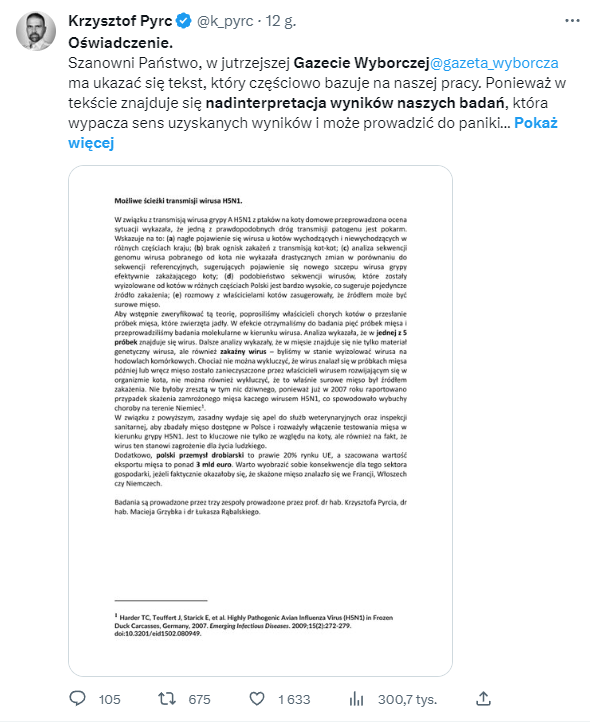
Based on their assessment of the situation, the researchers believe that one of the likely routes of transmission of the pathogen is through food. This conclusion is supported by the following findings:
- sudden outbreak of the virus in both outdoor and indoor cats in different parts of the country;
- no outbreaks of infection with cat-to-cat transmission;
- the analysis of the genome sequence of the virus collected from the cat did not reveal drastic changes compared to reference sequences, which could suggest the emergence of a new influenza virus strain efficiently infecting cats;
- the similarity of virus sequences that have been isolated from cats in different parts of Poland is very high, suggesting a single source of infection;
- interviews with cat owners suggested that the source may be raw meat.
The researchers asked the caretakers of the sick cats to send in samples of the meat they fed the animals. As a result, they obtained five samples, which they subjected to molecular tests for the virus. One of the five samples tested positive.
Further analysis showed that the meat contained not only the genetic material of the virus, but also the infectious virus – we were able to isolate the virus in cell cultures. Although it cannot be ruled out that the virus found its way into the meat samples later, or even that the meat was contaminated by the owners with the virus developing in the cat’s body, it also cannot be ruled out that the raw meat was the source of the infection. In fact, this would not be surprising, as a case of contamination of frozen duck meat with the H5N1 virus was already reported in 2007 [1], resulting in disease outbreaks in Germany.
In view of the above, an appeal to the veterinary services and the health inspectorate to examine the meat available in Poland and to consider including meat testing for H5N1 influenza seems justified. This is crucial not only because of the cats, but also because this virus is a threat to human life. In addition, the Polish poultry industry accounts for almost 20% of the EU market and the estimated value of meat exports is over €3 billion. It is worth envisaging the consequences for this sector of the economy if it were to turn out that contaminated meat had found its way to France, Italy or Germany.
4 July 2023
On Tuesday, Gazeta Wyborcza published the aforementioned text on its website with the corrections sought by the scientists. However, the pre-authorization version of the text was available in the paper edition. The article incorrectly suggested that scientists had confirmed the presence of the avian flu virus in meat available in Polish stores.
Wyborcza’s material met with an immediate response from the National Poultry Council – Chamber of Commerce. In an official statement, the Council demands the cessation of publishing information that is not confirmed in official announcements of state services. The poultry industry also expresses interest in a reliable explanation of the case, but believes that the research should be conducted by veterinary and sanitary services. Wild birds are the most likely source of infection, according to poultry farmers. The Council also condemns “any attempt to discredit the quality of Polish meat” and claims that Polish poultry meat “was, is and will be safe.”
On that day, the Chief Veterinary Officer decided that infections of companion animals with avian influenza viruses will be subject to the supervision of the Veterinary Inspectorate. Therefore, the CVO prepared templates of documents for the Veterinary Inspectorate and veterinarians: medical and veterinary interview and a letter attached to the samples.
An official statement was also released by the Chief Sanitary Inspector. It informs that the State Sanitary Inspectorate has taken preventive measures to prevent the occurrence of the disease in humans, among others by extending epidemiological supervision to the owners of cats confirmed to be infected with the avian influenza virus. These people will be contacted by employees of district sanitary and epidemiological stations. However, the Chief Sanitary Inspector reassures that the risk of infection transmission from a sick cat to a human is negligible.
5 July 2023
On Wednesday morning, a press conference was held at the Ministry of Agriculture and Rural Development. During the meeting, Deputy Minister Krzysztof Ciecióra assured that there was no threat to consumers. In his opinion, Polish poultry is of high quality, and the information about the avian flu virus in poultry meat is the result of manipulation by the reporters of Gazeta Wyborcza. In his speech, he praised the successes of the Polish poultry sector, including its export value.
Next, the director of the Veterinary Institute in Puławy, prof. dr hab. Stanisław Winiarczyk, stated that infections of cats with the H5N1 virus are nothing new and usually outbreaks of infection self-extinguish. A total of 43 samples were tested at the institute and 22 tested positive for H5N1.
The Chief Veterinary Officer, Paweł Niemczuk, stated that the numbers of both the samples and the cases of cat diseases are decreasing. Though he did not provide any specific figures. The conference was also attended by the president of the Polish Meat Association — Witold Choiński, whose speech focused on how profitable the Polish poultry industry is.
Referring to the appeal of prof. Krzysztof Pyrć to the services to consider including meat testing for H5N1, RMF journalist Maciej Sztykiel asked whether meat is tested in this direction on a daily basis. The question was answered by Paweł Niemczuk:
Not every meat is tested on a daily basis. Poultry is. There is a national avian influenza control program and flocks to be sampled are identified. The plan includes over 10,000 flocks, and more than 8,000 have been tested. If the poultry is infected, it shows signs of the disease and you can see it immediately because there are high deaths. But prior to that, animals stop eating, stop drinking, they show symptoms of illness – it shows. Doctors and breeders know very well what avian influenza looks like in poultry; therefore, only healthy poultry can go to the slaughterhouse.
Although the situation regarding cat infections has been supervised by the Veterinary Inspectorate, cat owners or veterinary clinics ordering the tests must pay for testing samples from infected animals (1, 2). According to Minister Ciecióra, the only laboratory in Poland that can detect the presence of the virus in meat is the National Veterinary Institute in Puławy. However, the NVI has not tested any meat samples fed to the animals so far.
The content of the initially uninformative statement released on 30 June was updated on the CVO’s website. After the update, it provides the results for the samples tested in the NVI (out of 29 samples, 20 tested positive for the H5N1 virus), and the locations the positive samples came from (Gdańsk, Gdynia, Poznań, Lublin, Pruszcz Gdański, Nowy Dwór Mazowiecki, Bydgoszcz and Wrocław). However, it is worth noting that the information was current as of 30 June, 2023.
Social media
An “investigative” group has been created on Facebook, associating over 9.7 thousand Internet users looking for answers. We understand that this topic evokes great emotions. However, we warn against uncritical faith in information shared on social media. Cases described in such groups can be multiplied, which gives a false impression of the scale of the problem and unnecessarily fuels emotions. Various medicines are also recommended in the group — we urge you not to give medicines to cats without consulting a veterinarian.
What is more, numerous narratives relating to the war in Ukraine or vaccines against COVID-19 can be observed in comments on social media. Remember to get information only from reliable sources.
![Mysterious cat disease in Poland turned out to be avian influenza? — What we know so far [Text updated]](https://fakenews.pl/en/wp-content/uploads/sites/2/2023/06/koty-1140x602-c-default.jpg)


